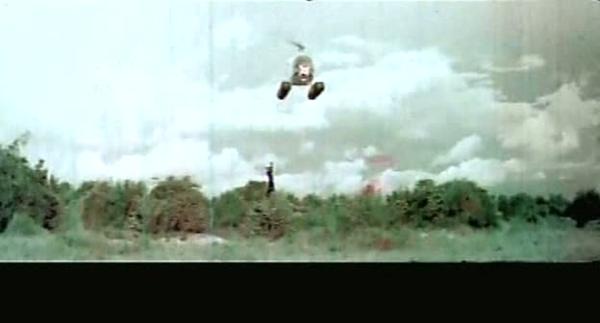Mitr Chaibancha (lost death footage of Thai actor; 1970): Difference between revisions
No edit summary |
mNo edit summary |
||
| Line 1: | Line 1: | ||
{{NSFL}} | {{NSFL}} | ||
{{InfoboxLost | {{InfoboxLost | ||
|title=<center>Mitr Chaibancha death footage</center> | |title=<center>Mitr Chaibancha (death footage)</center> | ||
|image=Inseethong18.jpg | |image=Inseethong18.jpg | ||
|imagecaption=Still from ''Insee Thong'' featuring Mitr hanging from the rope ladder. | |imagecaption=Still from ''Insee Thong'' featuring Mitr hanging from the rope ladder. | ||
|status=<span style="color:red;">'''Lost'''</span> | |status=<span style="color:red;">'''Lost'''</span> | ||
}} | }} | ||
'''Mitr Chaibancha''' was an actor from Phetchaburi, Thailand, who is often regarded as an icon of the country's cinematic golden age. While he is largely unknown outside of Thailand, in his home country, he was a borderline superstar, starring in nearly half of the 75 to 100 films produced yearly by the Thai film industry at his peak. He remains best known in Thailand for his numerous films with Thai actress Petchara Chaowarat, with the pair first appearing together in the 1961 film ''Banthuk Rak Pimchawee'' (''Love Diary of Pimchawee''), before later going on to make around 165 films together. | '''Mitr Chaibancha''' was an actor from Phetchaburi, Thailand, who is often regarded as an icon of the country's cinematic golden age. While he is largely unknown outside of Thailand, in his home country, he was a borderline superstar, starring in nearly half of the 75 to 100 films produced yearly by the Thai film industry at his peak. He remains best known in Thailand for his numerous films with Thai actress Petchara Chaowarat, with the pair first appearing together in the 1961 film ''Banthuk Rak Pimchawee'' (''Love Diary of Pimchawee''), before later going on to make around 165 films together. | ||
| Line 23: | Line 22: | ||
|description1 =YouTube video containing footage of available ending (7:01-7:27). | |description1 =YouTube video containing footage of available ending (7:01-7:27). | ||
}} | }} | ||
==External Links== | ==External Links== | ||
*[https://en.wikipedia.org/wiki/Mitr_Chaibancha Wikipedia page for Mitr Chaibancha] Retrieved 07 Jan '21 | *[https://en.wikipedia.org/wiki/Mitr_Chaibancha Wikipedia page for Mitr Chaibancha.] Retrieved 07 Jan '21 | ||
*[https://en.wikipedia.org/wiki/Insee_thong Wikipedia page for ''Insee Thong''] Retrieved 07 Jan '21 | *[https://en.wikipedia.org/wiki/Insee_thong Wikipedia page for ''Insee Thong''.] Retrieved 07 Jan '21 | ||
[[Category:Lost recordings of real incidents]] | [[Category:Lost recordings of real incidents]] | ||
[[Category:Completely lost media]] | [[Category:Completely lost media]] | ||
Revision as of 16:01, 9 January 2021
Mitr Chaibancha was an actor from Phetchaburi, Thailand, who is often regarded as an icon of the country's cinematic golden age. While he is largely unknown outside of Thailand, in his home country, he was a borderline superstar, starring in nearly half of the 75 to 100 films produced yearly by the Thai film industry at his peak. He remains best known in Thailand for his numerous films with Thai actress Petchara Chaowarat, with the pair first appearing together in the 1961 film Banthuk Rak Pimchawee (Love Diary of Pimchawee), before later going on to make around 165 films together.
Fatal fall
In 1970, production began on what would ultimately turn out to be Mitr's final film, Insee Thong (Golden Eagle). The film was notable at the time of its production for being the first film Mitr himself produced and directed, as well as for featuring the return of Insee Daeng (Red Eagle), a popular masked crime-fighter character played by Mitr who had previously appeared in the 1959 film Chao Nakleng (Gangster Lord).
On October 8th, 1970, as part of the final day of shooting, a scene was to be shot for the film's closing sequence in which Red Eagle climbs upon a rope ladder hanging beneath a helicopter before being flown off into the sunset in true action hero fashion. However, when it came time to film the scene, the helicopter flew too high above the ground for the rope ladder to be properly climbed upon, with Mitr only being able to reach the bottom rung of the ladder with his hands. As the helicopter began to take flight, Mitr was left dangling perilously above the ground, with nothing but the bottom rung of the rope ladder to hang on to. The helicopter pilot was unaware of this and thus allowed the helicopter to continue its ascent, with Mitr eventually losing his grip and falling to the ground, being killed instantly upon impact. His death would prove to be another significant blow to the Thai film industry in 1970, occurring mere months after pioneering Thai director Rattana Pestonji collapsed and later died of a coronary while giving an impassioned speech in support of Thai filmmaking.
Availability
As the cameras were filming the entirety of the helicopter's ascent, Mitr's fall to the ground was caught on camera. When Insee Thong was initially released in theatres in 1970, the bizarre decision was made to include the footage in the final cut. However, in what fashion it was incorporated remains unknown. However, when the film was released on DVD in 2005, the complete footage of Mitr's death was removed, with the film cutting away after the helicopter begins to take flight. The footage of Mitr's fall was instead replaced with further footage of the helicopter followed by a text scroll commemorating the actor's life. Since then, no footage of Mitr falling has made its way into public consumption, be it through a copy of the theatrical cut of the film or any other channels. Those who may be in possession of the footage would presumably also be unlikely to release it in order to pay respect to Mitr's memory, leaving the footage of his fall unlikely to resurface.
Gallery
External Links
- Wikipedia page for Mitr Chaibancha. Retrieved 07 Jan '21
- Wikipedia page for Insee Thong. Retrieved 07 Jan '21

